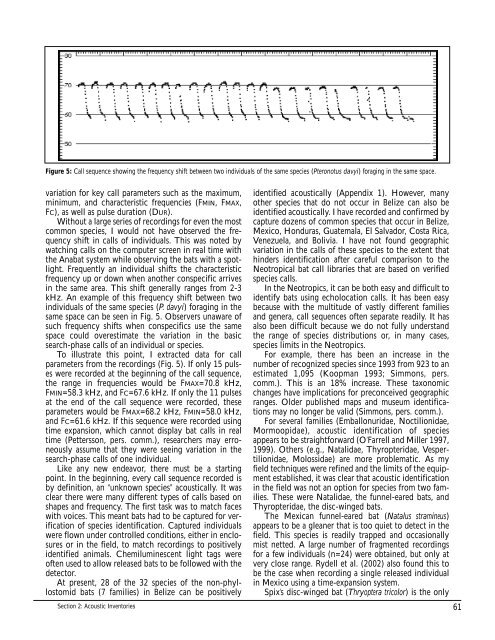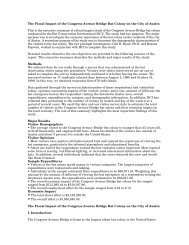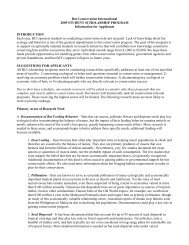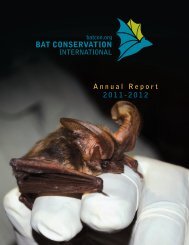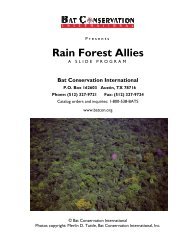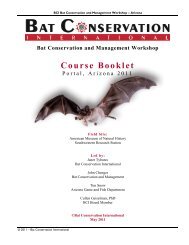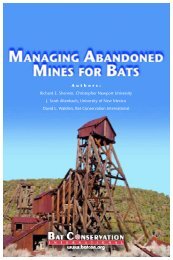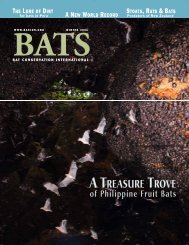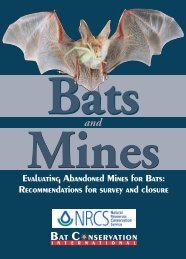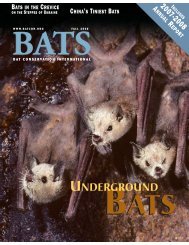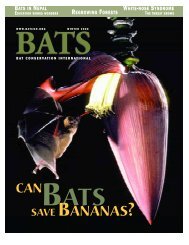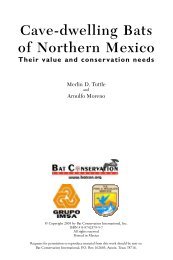Bat Echolocation Researc h - Bat Conservation International
Bat Echolocation Researc h - Bat Conservation International
Bat Echolocation Researc h - Bat Conservation International
Create successful ePaper yourself
Turn your PDF publications into a flip-book with our unique Google optimized e-Paper software.
Figure 5: Call sequence showing the frequency shift between two individuals of the same species (Pteronotus davyi) foraging in the same space.<br />
variation for key call parameters such as the maximum,<br />
minimum, and characteristic frequencies (FMIN, FMAX,<br />
FC), as well as pulse duration (DUR).<br />
Without a large series of recordings for even the most<br />
common species, I would not have observed the frequency<br />
shift in calls of individuals. This was noted by<br />
watching calls on the computer screen in real time with<br />
the Anabat system while observing the bats with a spotlight.<br />
Frequently an individual shifts the characteristic<br />
frequency up or down when another conspecific arrives<br />
in the same area. This shift generally ranges from 2-3<br />
kHz. An example of this frequency shift between two<br />
individuals of the same species (P. davyi) foraging in the<br />
same space can be seen in Fig. 5. Observers unaware of<br />
such frequency shifts when conspecifics use the same<br />
space could overestimate the variation in the basic<br />
search-phase calls of an individual or species.<br />
To illustrate this point, I extracted data for call<br />
parameters from the recordings (Fig. 5). If only 15 pulses<br />
were recorded at the beginning of the call sequence,<br />
the range in frequencies would be FMAX=70.8 kHz,<br />
FMIN=58.3 kHz, and FC=67.6 kHz. If only the 11 pulses<br />
at the end of the call sequence were recorded, these<br />
parameters would be FMAX=68.2 kHz, FMIN=58.0 kHz,<br />
and FC=61.6 kHz. If this sequence were recorded using<br />
time expansion, which cannot display bat calls in real<br />
time (Pettersson, pers. comm.), researchers may erroneously<br />
assume that they were seeing variation in the<br />
search-phase calls of one individual.<br />
Like any new endeavor, there must be a starting<br />
point. In the beginning, every call sequence recorded is<br />
by definition, an “unknown species” acoustically. It was<br />
clear there were many different types of calls based on<br />
shapes and frequency. The first task was to match faces<br />
with voices. This meant bats had to be captured for verification<br />
of species identification. Captured individuals<br />
were flown under controlled conditions, either in enclosures<br />
or in the field, to match recordings to positively<br />
identified animals. Chemiluminescent light tags were<br />
often used to allow released bats to be followed with the<br />
detector.<br />
At present, 28 of the 32 species of the non-phyllostomid<br />
bats (7 families) in Belize can be positively<br />
Section 2: Acoustic Inventories<br />
identified acoustically (Appendix 1). However, many<br />
other species that do not occur in Belize can also be<br />
identified acoustically. I have recorded and confirmed by<br />
capture dozens of common species that occur in Belize,<br />
Mexico, Honduras, Guatemala, El Salvador, Costa Rica,<br />
Venezuela, and Bolivia. I have not found geographic<br />
variation in the calls of these species to the extent that<br />
hinders identification after careful comparison to the<br />
Neotropical bat call libraries that are based on verified<br />
species calls.<br />
In the Neotropics, it can be both easy and difficult to<br />
identify bats using echolocation calls. It has been easy<br />
because with the multitude of vastly different families<br />
and genera, call sequences often separate readily. It has<br />
also been difficult because we do not fully understand<br />
the range of species distributions or, in many cases,<br />
species limits in the Neotropics.<br />
For example, there has been an increase in the<br />
number of recognized species since 1993 from 923 to an<br />
estimated 1,095 (Koopman 1993; Simmons, pers.<br />
comm.). This is an 18% increase. These taxonomic<br />
changes have implications for preconceived geographic<br />
ranges. Older published maps and museum identifications<br />
may no longer be valid (Simmons, pers. comm.).<br />
For several families (Emballonuridae, Noctilionidae,<br />
Mormoopidae), acoustic identification of species<br />
appears to be straightforward (O’Farrell and Miller 1997,<br />
1999). Others (e.g., Natalidae, Thyropteridae, Vespertilionidae,<br />
Molossidae) are more problematic. As my<br />
field techniques were refined and the limits of the equipment<br />
established, it was clear that acoustic identification<br />
in the field was not an option for species from two families.<br />
These were Natalidae, the funnel-eared bats, and<br />
Thyropteridae, the disc-winged bats.<br />
The Mexican funnel-eared bat (Natalus stramineus)<br />
appears to be a gleaner that is too quiet to detect in the<br />
field. This species is readily trapped and occasionally<br />
mist netted. A large number of fragmented recordings<br />
for a few individuals (n=24) were obtained, but only at<br />
very close range. Rydell et al. (2002) also found this to<br />
be the case when recording a single released individual<br />
in Mexico using a time-expansion system.<br />
Spix’s disc-winged bat (Thryoptera tricolor) is the only<br />
61


